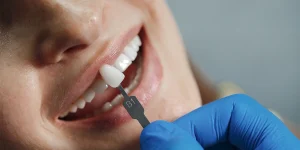When surgery ends, you feel two things at once: relief and a dozen small questions. Dental implant healing answers those questions in stages. Knowing what happens first, what to protect, and how long recovery takes removes uncertainty and helps you act with purpose.
This guide breaks dental implant recovery into clear windows so you know what to do from the first day through full bone integration. You will get practical steps for pain control, wound care, diet, and oral hygiene. You will also learn when to call your clinician and how timelines differ for single implants, multiple implants, and full mouth solutions.
Want a recovery plan built for your health and schedule? Book a consultation, and we will tailor the timeline to your case.
[toc]
Day 0 to Day 3: What to do immediately after implant surgery
The first 72 hours set the tone for dental implant healing. Your body forms a clot, inflammation peaks, and the site begins its first repair steps. Act gently and follow the plan your surgeon gives you.
Immediate actions
- Rest and avoid exertion for 24 hours. Movement raises blood pressure and can increase bleeding.
- Control swelling with ice packs applied intermittently for 10 to 15 minutes. Use a thin cloth between the skin and the ice.
- Take prescribed pain medicine and antibiotics exactly as directed. Follow your clinician’s analgesic plan rather than guessing doses; this is vital for smooth dental implant healing.
- Keep the head elevated during sleep for the first two nights to limit swelling.
- Avoid rinsing, spitting, or using a straw for the first 24 hours to protect the delicate clot and ensure proper tooth implant recovery.
Oral care in the first days
- Rinse gently with warm salt water starting 24 hours after surgery, three times a day. Use a half teaspoon of salt in 8 ounces of water.
- Brush other teeth as usual, but clean near the surgical site very gently. Do not disturb any sutures during your dental implant recovery.
- For single-tooth cases, simple home care usually suffices. However, for multiple implants or full mouth implants, strictly follow the clinic’s specific rinse and cleaning schedule for effective recovery from dental implants.
Red Flags to Report to Your Team During Dental Implant Recovery
- Excessive bleeding that soaks gauze after two hours.
- Fever above 101°F or increasing pain after the second day.
- Numbness that does not gradually improve.
If any of these occur, contact your implant team immediately. Early intervention prevents complications and supports successful dental implant healing.
Day 4 to Day 14: Early Dental Implant Healing
By day four, swelling and bruising usually peak and then begin to subside. Tissue closes over the wound, and the risk of infection falls if you have kept the area clean. This window moves you from fragile care toward routine dental implants recovery.
What you will notice
- Swelling decreases, and discomfort shifts from sharp to dull.
Sutures often come out between day seven and day ten, depending on the technique. Your clinician will advise timing. - You may feel tightness or mild tenderness as the gum tissue firms up around the implant site, a positive sign in the recovery time for dental implants.
Practical steps for this stage
- Continue gentle saltwater rinses and switch to your normal soft toothbrush around the site as comfort allows.
- Introduce more textured soft foods such as mashed potatoes, soft pasta, and tender cooked vegetables. Avoid hard, crunchy, or sticky items.
- Keep alcohol and tobacco away. Smoking impairs blood flow and severely delays osseointegration, significantly prolonging dental implant recovery.
- If you use a temporary crown or prosthesis, follow specific cleaning instructions and avoid chewing on that side until cleared. Adherence to this protocol improves the entire recovery time for dental implants.
When to call the clinic
- Persistent pus, spreading redness, or a rising fever.
- A loose implant or prosthesis.
- Unusual or worsening pain after an initial improvement.
Across all cases, including full mouth implants, the same principle holds: protect the site, keep it clean, and report changes early. These two weeks build the foundation for bone fusion. Follow-up visits confirm healing and let your team adjust the plan, securing long-term dental implant success.
Weeks 3 to 8: Continued Dental Implant Healing and Functional Return
By week three, you should notice steady improvement. Tenderness fades, swelling settles, and you can return to more normal foods. This stage matters for successful dental implant healing because new bone begins to bridge the implant surface and the jaw. Protecting that forming bond speeds recovery from dental implants.
Practical steps for dental implant healing
- Gradually reintroduce firmer foods. Start with soft bites and avoid direct heavy chewing on the new implant for another few weeks.
- Keep cleaning with interdental brushes and a soft toothbrush. Focus on gentle, thorough plaque control around the emergence of the crown or healing cap.
- Use a water flosser if your clinician recommends it; it flushes debris without abrading healing tissue. This is key for sustained dental implant healing.
- Maintain all follow-up visits as scheduled. Your dentist checks pocket depths, tissue health, and any early signs of inflammation crucial to your recovery time for dental implants.
What to expect biologically during recovery from dental implants
- Bone remodels and tightens around the implant. This phase leads to true osseointegration.
- Minor sensitivity or tightness can persist as tissues mature.
- If you received provisional teeth, your clinician may adjust how the teeth meet (occlusion) to avoid excessive load during your recovery time for dental implants.
When to Contact Your Team During Dental Implant Recovery
- Increasing pain, new swelling, or drainage.
- Loosening of a healing cap or temporary crown.
- Any fever or rapid change in comfort.
Early detection of peri-implantitis or mechanical issues keeps long-term tooth implant recovery on track.
Months 3 to 6 and Beyond: Full Recovery Time for Dental Implants and Long-Term Success
Most implants achieve solid osseointegration between three and six months. At this point, the clinician typically places the abutment and final crown, completing your tooth implant recovery. For solutions like full mouth implants (e.g., All-on-X), clinicians follow a similar biological timetable but plan prosthesis changes carefully to spread forces, ensuring the protection of the healing bone.
Daily maintenance for longevity
- Brush twice daily with a low-abrasive toothpaste and a soft brush.
- Clean interdental areas daily with brushes or specialized floss. This is the cornerstone of preventing peri-implant disease.
- Attend professional cleanings every three to six months based on risk. Hygienists remove calculus and check the implant interface.
- Avoid smoking and limit alcohol. Both slow healing and raised long-term failure risk.
Keep a healthy diet that supports bone health, including calcium and vitamin D.
Long-term expectations and checkups
- Most implants last for decades with good care. Regular reviews spot early bone loss or gum inflammation.
- Full mouth implants need ongoing prosthesis checks, screw torque monitoring, and hygiene coaching.
- If you notice bleeding, persistent bad taste, or loosening at any time, contact your implant team. These are signs to address immediately.
Recovery time for dental implants varies by case. Single-tooth implants often follow the timeline above. Full arch solutions may need staged adjustments, but the same rule applies: conservative load, meticulous hygiene, and regular professional care create durable results and make dental implant recovery predictable and successful.
How Often Should I See The Dentist For Maintenance of Dental Implants?
Most clinicians recommend a check every three to six months in the first year, then at least twice a year if healing is uneventful. Your team may ask for more frequent visits when risk factors exist.
What happens at a dental implant maintenance visit
- The clinician inspects soft tissue for redness, bleeding, or pus.
- The hygienist removes hardened deposits around the implant using instruments safe for titanium.
- Staff measure probing depths to watch for peri-implant pockets.
- X-rays are taken when there is clinical concern or at scheduled intervals to monitor the bone level.
- Technicians check prosthesis fit, screw torque, and signs of wear on crowns or full-arch bridges.
Why this matters
Professional cleaning removes calculus and biofilm that your brush cannot reach. Early detection of bone loss or inflammation makes non-surgical treatment possible. In short, routine care protects the long-term outcome of dental implant healing.
Do Different Implant Types Need Specialized Implant Care Dental?
Yes. The principles of hygiene and avoidance of tobacco apply to all implants, yet the specifics change by design.
Single-tooth implants
- Clean at the crown margin daily with interdental brushes and floss.
- Watch the gum line for inflammation where the abutment meets tissue.
Multiple implants and implant bridges
- Use interdental brushes between the pontics and flush under connectors with a water flosser.
- Attend professional hygiene visits to remove plaque around connectors and screws.
Full-arch and All-on-X prostheses
- If removable, clean the prosthesis nightly and soak it if instructed.
- If fixed, maintain access points with specialized brushes and schedule more frequent professional cleaning.
- Technicians monitor screw stability and prosthetic wear because mechanical problems can compromise healing.
Special medical situations
- Smokers, poorly controlled diabetics, and patients on certain medications face increased implant failure risk. They need closer follow-up and a stricter hygiene plan to secure dental implant recovery.
Frequently Asked Questions
Do full mouth transplants heal differently from single transplants?
The biological stages are the same, but clinicians stage load and prosthesis adjustments to spread forces and protect bone during healing.
How long is the recovery time for dental implants?
Initial comforts come in days, but the full bone integration can take three to six months. Complex cases or grafting can extend that timeline.
Protect Your Investment Schedule Your Next Visit
Successful dental implant healing is not left to chance; it is built on deliberate action. This guide provided clear steps for wound care, hygiene, and anticipating the recovery time for dental implants. By adhering to the immediate care protocol and scheduling regular professional maintenance of dental implants, you actively protect the crucial bone fusion. Don’t wait until discomfort signals an issue.
Book your personalized consultation today to secure the long-term success and full function of your beautiful implant.




